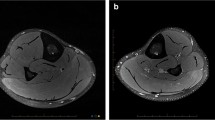Abstract
Objective
Calf muscle strains have become increasingly prevalent in recent seasons of the Australian Football League (AFL) and represent a significant cause of time lost from competition. The purpose of this study was to examine the association between MRI features of calf muscle strains and games missed and to thereby identify parameters that are of prognostic value.
Materials and methods
A retrospective analysis of MRI scans of AFL players with calf strains referred to a musculoskeletal radiology clinic over a 5-year period (2008–2012) was performed. The muscle(s) and muscle component affected, the site and size of strain, and the presence of an intramuscular tendon tear or intermuscular fluid were recorded. These data were cross-referenced with whether a player missed at least one game. Imaging features of prognostic value were thus identified.
Results
Sixty-three athletes had MRI scans for calf muscle strains. Soleus strains were more common than strains of other muscles. Players with soleus strains were more likely to miss at least one game if they had multiple muscle involvement (p = 0.017), musculotendinous junction strains (p = 0.046), and deep strains (p = 0.036). In a combined analysis of gastrocnemius and soleus strains, intramuscular tendon tears were observed in a significantly greater proportion of players who missed games (p = 0.010).
Conclusion
Amongst AFL players with calf injuries, there is an association between missing at least one game and multiple muscle involvement, musculotendinous junction strains, deep strain location, and intramuscular tendon tears. In this setting, MRI may therefore provide prognostic information to help guide return-to-play decisions.






Similar content being viewed by others
References
Orchard J, Seward H, Orchard J. 23rd Annual AFL Injury Report: 2014.
Elkstrand J, Healy JC, Walden M, Lee JC, English B, Hagglund M. Hamstring muscle injuries in professional football: the correlation of MRI findings with return to play. Br J Sports Med. 2012;46:112–7.
Elliot MC, Zarins B, Powell JW, Kenyon CD. Hamstring muscle strains in professional football players: a 10 year review. Am J Sports Med. 2011;39:843–50.
De Smet AA, Best TM. MR Imaging in the distribution and location of acute hamstring injuries in athletes. AJR Am J Roentgenol. 2000;174:393–400.
Slavotinek JP, Verrall GM, Fon GT. Hamstring injury in athletes: using MR imaging measurements to compare extent of muscle injury with amount of time lost from competition. AJR Am J Roentgenol. 2002;179:1621–8.
Comin J, Malliaris P, Baquie P, Barbour T, Connell D. Return to competitive play after hamstring injuries involving disruption of the central tendon. Am J Sports Med. 2013;41:111–5.
Pomeranz SJ, Heidt RS. MR imaging in the prognostication of hamstring injury. Work in progress. Radiology. 1993;189:897–900.
Balius R, Alomar X, Rodas G, Miguel-Perez M, Pedret C, Dobado MC, et al. The soleus muscle: MRI, anatomic and histologic findings in cadavers with clinical correlation of strain injury distribution. Skeletal Radiol. 2013;42:521–30.
Aughey R. Australian football player work rate: evidence of fatigue and pacing? Int J Sports Physiol Perform. 2010;5:394–405.
Lee JC, Mitchell AWM, Healy JC. Imaging of muscle injury in the elite athlete. Br J Radiol. 2012;85:1173–85.
Pedret C, Rodas G, Balius R, et al. Return to play after soleus muscle injuries. Orthop J Sports Med. 2015;3(7):2325967115595802.
Orchard J, Best TM, Verrall GM. Return to play following muscle strains. Clin J Sport Med. 2005;15:436–41.
Delgado GJ, Ching CB, Lektrakul N, Azocar P, Botte MJ, Coria D, et al. Tennis leg: clinical US study of 141 patients and anatomic investigation of four cadavers with MR imaging and US. Radiology. 2002;224(1):112–9.
Koulouris G, Ting A, Jhamb A, Connell D, Kavanagh EC. Magnetic resonance imaging findings of injuries to the calf muscle complex. Skeletal Radiol. 2007;36:921–7.
Palmer WE, Kuong SJ, Elmadbouh HM. MR imaging of myotendinous strain. AJR Am J Roentgenol. 1999;173:703–9.
Garrett Jr WE. Muscle strain injuries. Am J Sports Med. 1996;24(6 Suppl):S2–8.
Cross TM, Gibbs N, Houang MT, Cameron M. Acute quadriceps muscle strains: magnetic resonance imaging features and prognosis. Am J Sports Med. 2004;32:710–9.
Frank C, Shrive N, Lo I, Hart D. Form and function of a tendon and ligament. In: Einhorn T, O’Keefe R, Buckwalter J, editors. Orthopaedic basic science: foundations of clinical practice. 3rd ed. Rosemont: American Academy of Orthopaedic Surgeons; 2007. p. 191–222.
Connell DA, Schneider-Kolsky ME, Hoving JL, Malara F, Buchbinder R, Koulouris G, et al. Longitudinal study comparing sonographic and MRI assessments of acute and healing hamstrings injuries. AJR Am J Roentgenol. 2004;183:975–84.
Acknowledgements
We thank the members of the AFL Medical Officers Association and Dr John Orchard. We also thank the MRI staff at Victoria House Medical Imaging.
Author information
Authors and Affiliations
Corresponding author
Ethics declarations
Conflicts of interest
The authors declare that they have no conflicts of interest.
Rights and permissions
About this article
Cite this article
Waterworth, G., Wein, S., Gorelik, A. et al. MRI assessment of calf injuries in Australian Football League players: findings that influence return to play. Skeletal Radiol 46, 343–350 (2017). https://doi.org/10.1007/s00256-016-2564-7
Received:
Revised:
Accepted:
Published:
Issue Date:
DOI: https://doi.org/10.1007/s00256-016-2564-7




